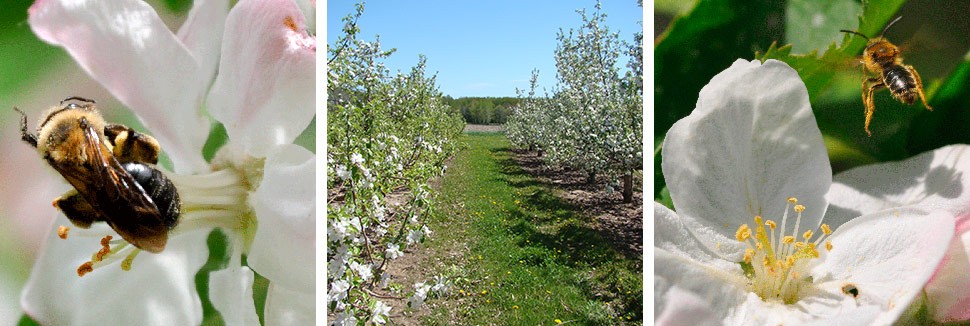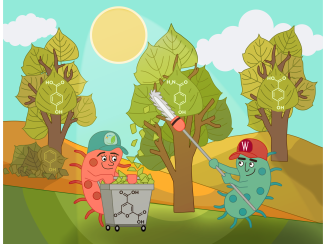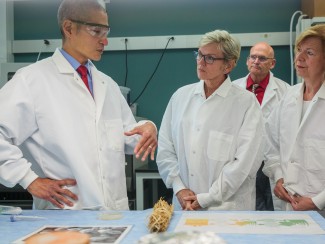
The next time you take a bite of a crisp fall apple, you might take a moment to reflect on the unique Wisconsin partnership that made it possible: farmers and bees.
With more than 500 species native to Wisconsin, wild bees play an essential role in pollinating the state’s food crops, and farmers are becoming more interested in learning about all the different kinds that buzz around their fields each season.
Fortunately, University of Wisconsin-Madison entomology graduate student Rachel Mallinger knows a lot about the native bees of the badger state. Mallinger, who works in the lab of Great Lakes Bioenergy Research Center sustainability scientist Claudio Gratton, has developed an online bee identification guide to benefit farmers, landowners and curious citizens.
Entitled “Spring Wild Bees of Wisconsin,” the resource will help users distinguish among different types of bees and learn about the important roles they play in nature and agriculture.
"My goals are two-fold: to satisfy people's curiosity and provide education, and also conservation," says Mallinger, who adds that she receives several requests for bee identification help every month.
"Some folks are simply curious, and others are interested in finding out how they can manage their land to support native bee species to pollinate their crops. If people notice a lot of a specific type of bee in their area, they can learn what kinds of resources they can provide to help it thrive."
People often try to get rid of bees because they think they are wasps, which do not have as many obvious benefits to humans. If people realize it's a bee, they might be much more likely to put up with it.
Rachel Mallinger
Funded by a USDA Sustainable Agriculture Research and Education (SARE) grant, the step-by-step guide presents spring native bees by type, such as the ubiquitous bumblebees (13 native species), the medium-sized black-and-white striped bees (200 species), and the surprisingly-blue Mason bees (7 species). In addition to identification, the guide provides users with information on the benefits of bees, such as pollination.
The guide helps users distinguish between bees and other similar insects, like wasps and flies. “People often try to get rid of bees because they think they are wasps, which do not have as many obvious benefits to humans,” says Mallinger. “If people realize it's a bee, they might be much more likely to put up with it.”
Mallinger's graduate research focuses on determining whether wild bee populations alone can adequately pollinate Wisconsin’s primary commercial fruit crops, which include cranberries, cherries, peaches, apricots, blueberries, strawberries, raspberries and apples. While she has found that native populations are indeed healthy enough to pollinate these crops, some farmers opt to bring additional, managed bees onto their land—mainly for peace of mind.
"I’ve found that the vast majority of farmers would do fine relying only on wild bees," says Mallinger. “Bringing in additional bees is more of an insurance policy.”
Deirdre Birmingham, co-owner of a 166-acre organic cider apple operation called The Cider Farm in Iowa County, relies exclusively on wild bees to pollinate her apple trees. In 2012, Mallinger surveyed The Cider Farm’s orchard and identified 15 different species of mining bees, bumble bees and sweat bees during the apple bloom season alone.
“Bees seem to prefer diversified environments. In addition to orchards, we have prairie, corn and alfalfa croplands, and woodlands,” says Birmingham. With so many different pollinators with different ecological niches, Birmingham says a wild bee field guide would be helpful for herself and her employees.
Other farmers who prefer to enlist outside help may contract with commercial beekeepers to truck as many as nine hives of managed bees per acre, at a cost of up to $100 per hive. Once delivered, a truckload of managed bees can keep busy pollinating a field for up to three weeks.
Given recent news of dwindling bee populations, it's not entirely surprising that farmers prefer the certainty that comes with managed pollination. While the cause or causes are still being studied, some U.S. bee species have been experiencing undeniable population declines.
"There are risks for crops and wild plants that rely on certain pollinators, and a decline in those pollinator species could have an effect," says Mallinger. She explains that as the diversity of bee types in an ecosystem decreases, the likelihood of a single disease wiping out the remaining bees increases. "Changing diversity makes systems less resilient,” she says.
Designed for species commonly found in the spring and early summer, the Spring Wild Bees of Wisconsin guide allows users to identify species using either picture matching or a dichotomous key. Mallinger hopes that the guide will allow citizens to share their observations in an effort to gather more data on the status of wild bees in Wisconsin.
“Farmers are very aware of how much work wild bees are doing,” says Mallinger. “They are very aware of bees’ importance, and this increases their interest in learning more about them.”





